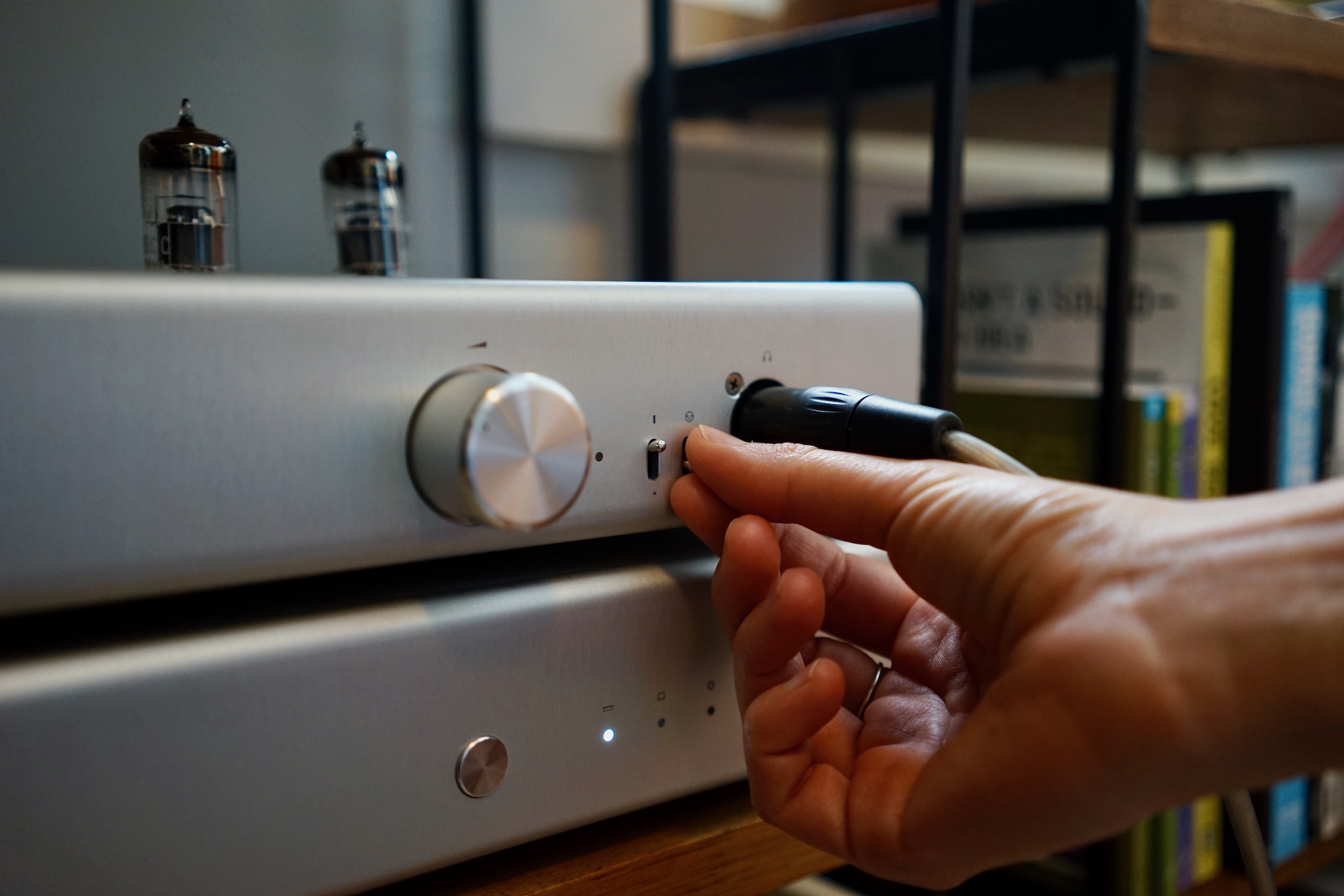LP12MF Listening Test: Before Any Modifications
The LP12 Modification Frenzy has begun: I have swapped my Cirkus shuchassis + laminated armboard for a one-piece machined aluminum Mober subchassis. Before doing that, I did my first detailed listening test, so that I could have a reasonably well-described “before” position against which to analyze these upgrades.
Methodology
I’m an English professor, not a scientist, or even a social scientist. So take this methodology as you will. It is probably not worthy of publication in a peer-reviewed journal. But this is my blog and I can publish whatever I want! And I think it makes a certain amount of sense.
Here’s what I’m going to do.
I have compiled, and described in some detail, a series of test tracks and test albums. Every time I make a modification to my LP12 — every time I swap a cartridge or a tonearm or a subchassis or a top plate — I am going to leave it in place for as many weeks or months as it takes me to listen to all my test albums.
Then I am going to do an A/B comparison in which I listen back-to-back to the vinyl setup in its current configuration and my digital setup in a stable configuration. In the A/B, “A” is the current vinyl setup; it will be different in every round. “B” is my digital setup, which will be the same every round. This way I will always have something stable to compare my current iteration of the modified table to do. Hopefully by keeping detailed impressions along the way, I’ll be able to see if “A” is getting better.
I’ll be able to tell, at every step, whether “A” is better than “B,” yes. But the really important thing is whether A3 is better than A2, or A2 is better than A1. Why don’t I just compare two turntables directly? Because I only have one; because it would be expensive to constantly have two nearly-identical turntables at every stage; because two “identical” LP12s will nonetheless have subtle differences between them (setup, springs, cartridge wear, bearing lubrication, etc. etc.) and thus really be comparable. But the digital should be the same every single time, so “B” should genuinely be comparable. The stability of “B” should allow me to use it as a point against which to compare the different iterations of “A.”
My digital setup
What is my digital setup, you will ask? It is:
- Roon streaming Tidal on an Apple iMac
- A Schiit Gungnir Multibit with Gen 5 USB connected to my iMac via a reasonably expensive USB cable (ugh), a Neo by Oyaide Elec d+ if you need the details, fed into the balanced input of a Schiit Mjolnir 2 via Schiit’s PYST balanced cables. The Mjolnir uses Telefunken E88CC preamp tubes.
(My analogue setup is an LP12 described in detail here, fed into a Dynavector P75mkI phono preamp, connected to the single-ended input of the same Mjolnir via Linn Silver RCA cables.)
You can see photos of everything here.
How I do the A/B testing
Here’s how I do my A/B testing. I sit right in front of my Mjolnir 2 on my desk chair with my Hifiman HE1000v2 headphones on. First I listen to the entire test track on vinyl, then I listen to the entire track on digital. (I reverse this order 50% of the time). Then I listen to the two of them with about a 10 second delay: I start the vinyl, listen for 10 seconds, then start the digital and listen for 10 seconds, then switch back until I hear something interesting, then listen to it on the trailing track (I’ll swap the leading/following track source 50% of the time). Then I start them both at the same time and toggle directly between the two. (This is usually the best way to appreciate differences.) I make notes throughout (on the Notes app on my laptop), focusing not just on which sounds best, but primarily on how they sound different.
I switch between the two sources with the Mjolnir’s two-way input switch (it only has two inputs: single-ended and balanced). This is a mechanical switch: up is balanced, down is single-ended. I do my best to keep the volume at the same level. Usually, balanced digital is louder, so when I switch inputs I also toggle the Mjolnir’s high/low gain switch, which is right next to the input switch. I then correct with the volume knob. I know loud sounds are generally perceived as sounding better, so it’s important I keep levels the same. My system isn’t perfect, but it’s the best I could come up with.
For this round, I listened to four tracks each in three sittings. It took me about three hours to do the twelve tracks this time.
Listening Test #1: Digital vs. Base (“Before”) Setup
Okay, with all that out of the way, here are my impressions on Listening Test #1, in which I compare my digital setup to the “pre-modification” Base setup described here: 1986 LP12 with Cirkus / Roksan Nima / Adikt / stock top plate. I’ll go track by track, working from my point form notes and occasionally editing for coherence. I’ll use the present tense, since these notes were written in real time (though they’re being edited now). Yes, I’ll save the raw, unedited notes for future reference. All of the below will make more sense if you’ve first read my Test Tracks post, in which I describe what I’m listening for in each song.
1. The Beach Boys, “I Know There’s an Answer,” Pet Sounds (1966)
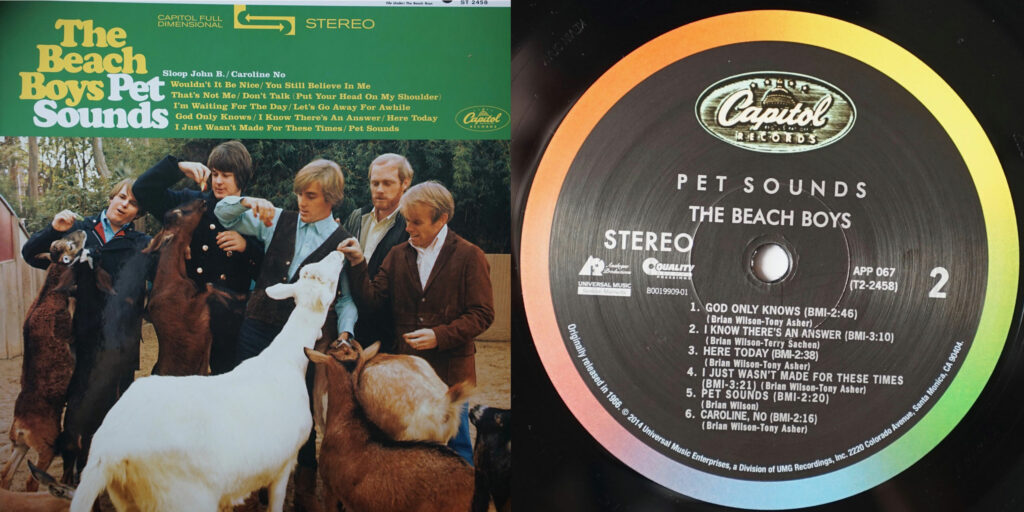
On listening to the full track on digital then vinyl, I liked vinyl better. It felt much deeper, rounder, more (quantity) of bass, and also a nice percussive quality, especially to the upright bass. Definitely seemed like there was more texture in the bass harmonica solo — like when you see a beer poured in a commercial and the bubbles are going nuts? The audio equivalent of that. Lots of bubbles!
Switching back and forth. It’s less clear (may have been a loudness issue, with vinyl favored by a louder sound?) But there are differences. Highs on vinyl are a little more hissy, but more present, more palpable, higher in the mix. For me, is in a good way. The frequency extremes on both sides seem exaggerated — it goes lower and higher (I realize this is probably the reverse of what’s actually happening, but this is how it feels/sounds). But yeah, a little shrill maybe? The vinyl sound is definitely smoother, more in control, a little less wild.
Direct second-to-second comparison. Yeah, they’re both really good, but there is a kind of “hardness” to the digital that vinyl doesn’t have… like a 99% transparent grey gradient in Photoshop put over top. I really like them both but I definitely do prefer vinyl. But it feels like a preference (especially for the bigger bottom end and the more present highs/shake) rather than an objective difference.
2. Charles Mingus, “Track B — Duet Solo Dancers,” The Black Saint and the Sinner Lady (1963)
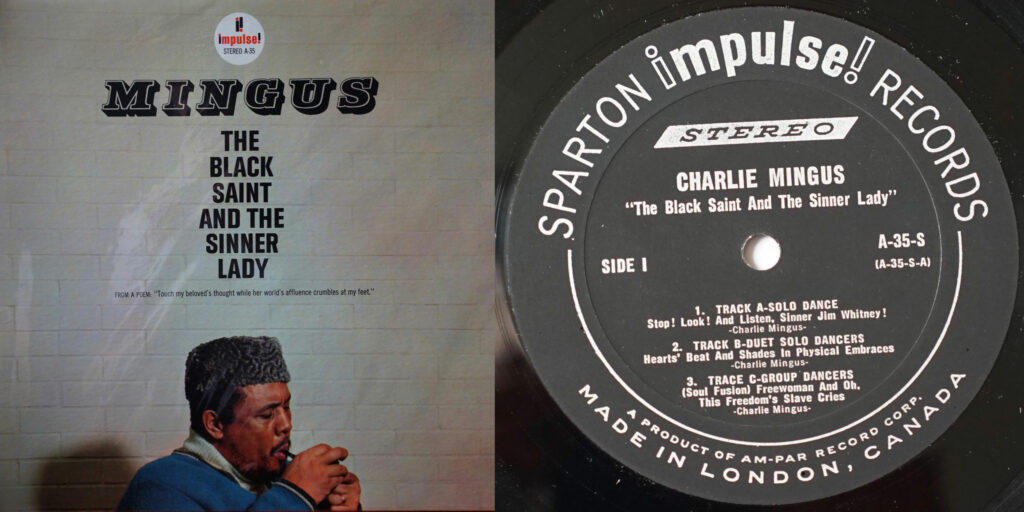
On listening to both tracks in full, back to back, digital seems to have the edge this time, with deeper bass, more detail (especially in the brushes on cymbals), and more “edge” to the to the brass. Might be a volume thing though?
In 10-second-delay and direct second-to-second, the bass has more detail and authority on vinyl, but there is more “tizz”: hings are rougher and more granular on vinyl. The vinyl textures are sometimes more pleasing and “organic,” but usually seem lower-resolution, less controlled and in focus. Cymbals have more “pointedness” and more space around them, more “air.” But all in all, digital wins this one: more controlled, more authoritative, more effortless.
Ah, but when I switch from the 1963 Sparton to my recent “Vital Vinyl” reissue (from digital masters, probably the same ones I’m getting on Tidal) it’s back to the Beach Boys scenario. They’re very similar, but the vinyl copy has a bit more body, higher highs, lower lows. All the failings noted above disappear. So it seems like more of a pressing issue. I’ll have to keep referring to this reissue when doing future tests. But it’s not all on the side of the reissue: the sub-bass sound at the start of the track is way more evident on the Sparton — and the Sparton is pressed much louder.
3. The Pentangle, “Let No Man Steal Your Thyme,” The Pentangle (1968)
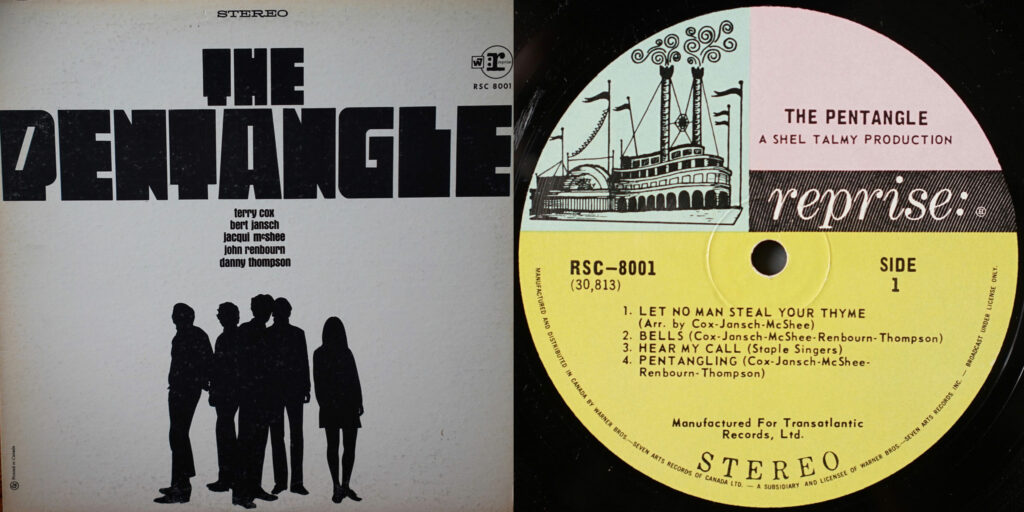
One-after-the-other: Digital sounds great — lively, tons of detail and range. Listening to the full track on vinyl right after, I hear surface noise, less focus, softer tones.
Direct back-and-forth: mostly a win for digital. Detail is much better on digital. This is especially clear in the triangle in the breakdown — it’s much more three-dimensional. But the rim hits sound great on vinyl — more percussive and present. There is still a lot of detail in the vinyl, and the bowed bass sounds amazing. But there is noticeably more detail present in digital.
The one win for vinyl the digital can feel strident — all those glassy sounds can be a wee bit painful on digital compared with vinyl.
I sense again that this is a pressing thing. I bet a better, cleaner pressing would have more detail (edit: I’m actively looking for a NM Transatlantic of this record to confirm). But it does seem like digital remasters are maybe a good thing 🙂 The whole “magic of AAA” thing I was feeling a few months ago might be wearing off a bit!
4. Mariah, “Shinzo No Tobira,” Utakata No Hibi (1983)
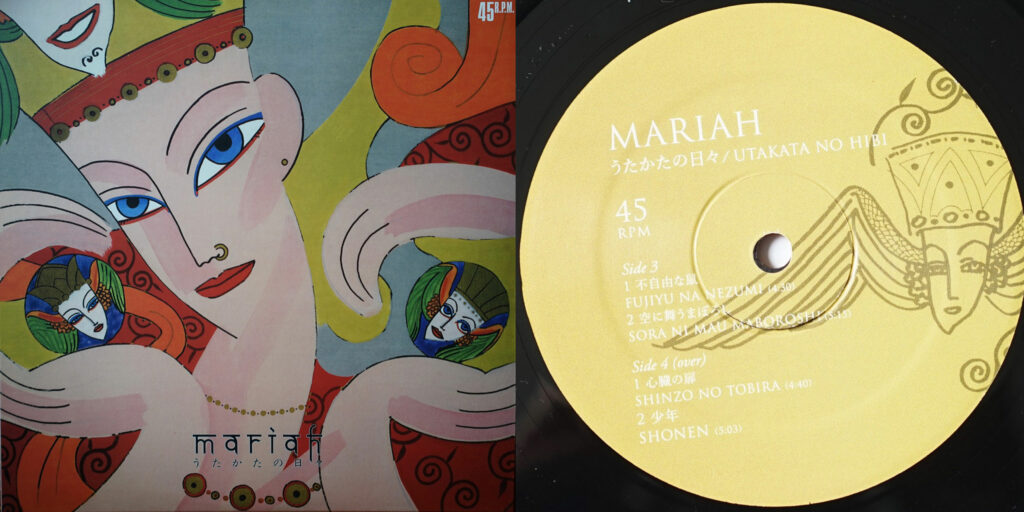
I started by listening to the opening on digital, then on vinyl. The key to this track is that dry, crackly, chain-reaction drum thing. It sounds better on digital, clearly. It is more delicate, more lifelike. It’s a little blunter on vinyl, with less rattle. The bass does sound a little more extended on vinyl — fuller, with more “bloom.” The breakdown on vinyl with the crunchy synths definitely sounds good on vinyl — but better on digital.
Doing back-to-back, they seem much closer than in one-after-the-other comparison. There’s a tiny bit less micro-detail on vinyl, but still plenty, and it sounds really nice. There is lightly less focus on vinyl. The left-right panning during the synth part hits a little harder on vinyl.
Overall: slightly richer on vinyl, but less detail, less focus, a little bit more fizz. More detail on digital, more control. They both definitely sound really good. Overall, I prefer the digital in the back-to-back for the superior detail and sense of space on the dry drum sound.
5. Joy Division, “Atmosphere,” 12″ single (1980)
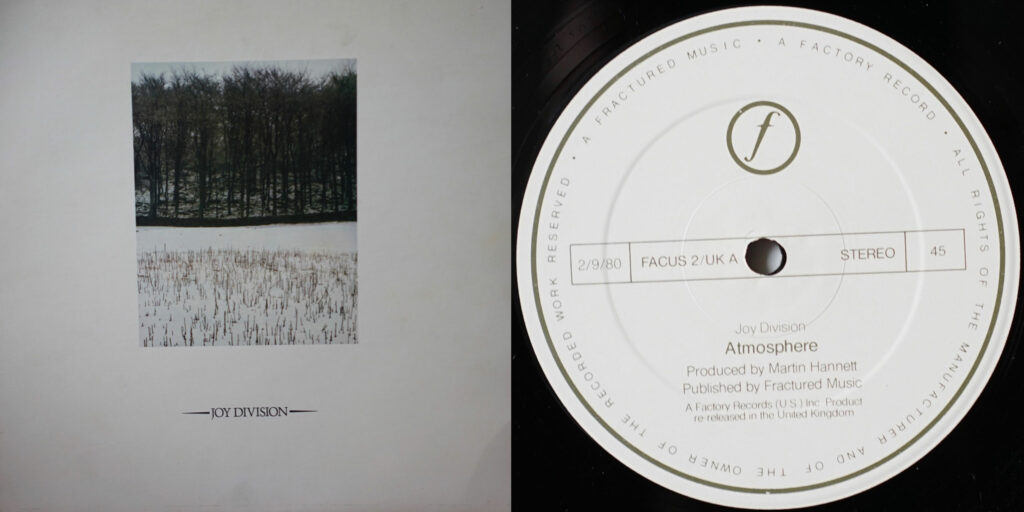
Doing a back-to-back acclimatization session, vinyl seems to sound a little better. The drums (i.e., the whole song, really!) are more natural, hitting a bit harder. I’m bit surprised by that after the dominance of digital in this session when it comes to slam and heft. But I haven’t done the back-to-back yet. It could just be a case of it being surprising that the vinyl comes close to the digital in this regard — of wanting it to sound better and giving it the tie…
Head-to-head: wow, yes, vinyl is hitting harder, and the drums are rounder, more real. Everything sounds just a little better on vinyl. The main thing: slam. Those smaller hand drums in the right channel in the latter half of the song sound more real on vinyl. The “icicle” synth is more spacious and detailed on vinyl. It’s kind of amazing how much better it sounds on vinyl, really.
6. Low, “Just Make It Stop,” The Invisible Way (2013)
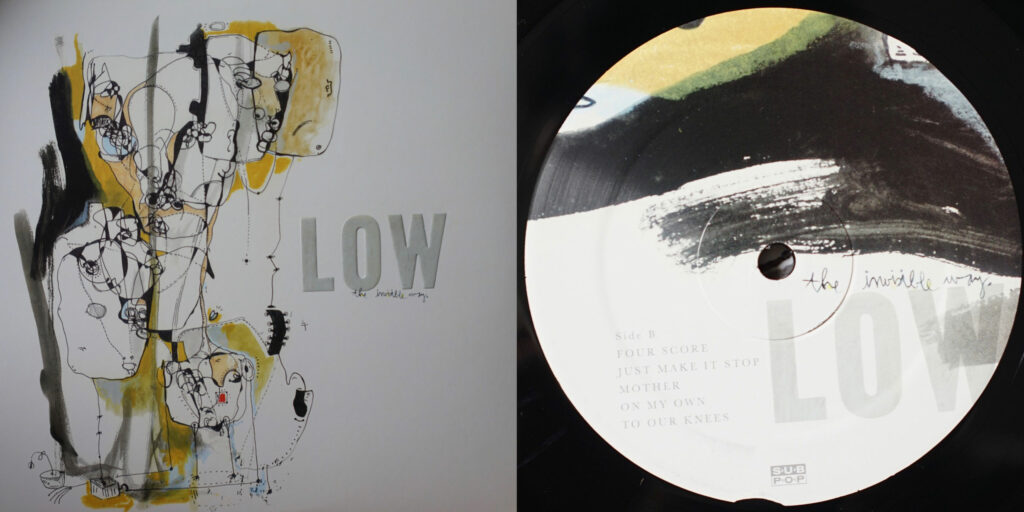
Whole song digital: sounds good but not blowing me away. Doesn’t feel as rich or spacious as I’m expecting.
Whole song vinyl: kind of the same, though. Joy Division’s “Atmosphere” really blew me away. This is less spectacular.
There is a bit more heft and detail in digital. Somehow the sub-piano is more present on vinyl despite the increased graininess of the vinyl. The graininess works for the guitar and voice — but is it “real”?
Second listen: Mimi’s voice feels a bit veiled on vinyl (which is WAY quieter, very very quiet pressing.) The low end has pleasing heft but less detail and control than digital.
Close, but I’d say that digital wins out a bit here.
7. Yo La Tengo, “Stockholm Syndrome,” I Can Feel the Heart Beating as One (1997)
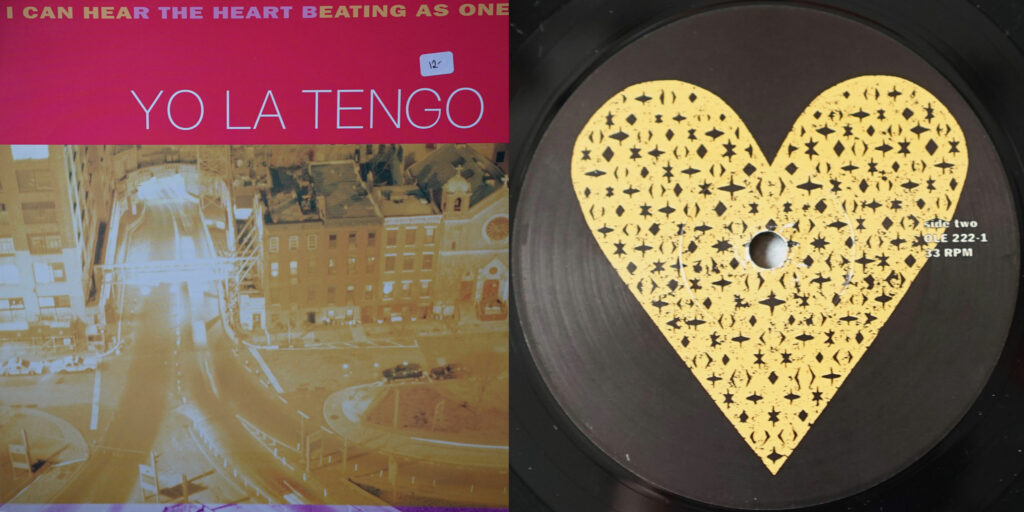
Digital full listen: full, rich, bass sounds great, lots of nice detail in the acoustic guitar. Little wood block is very clear [Ed: Here, as elsewhere, the thing I’m talking about is described in the original Test Tracks post.] Whatever that echoey background thing is, like light static electricity, is really nice, too.
Vinyl full listen: Bass seems less focused, but maybe the percussion and the acoustic guitar are a little snappier? And is bass is a little boomy here. (Fair amount of surface noise — might need a bath in Spin Clean #2! [Ed: I did give it another wash in my revised Spin Clean setup — on which more later — but it didn’t make a difference].) The background haze thing is less distinct here. Yeah, maybe the guitar-pick-on-steel-strings texture/zip is nicer here?
Side-by-side: more low end on vinyl — which is mostly more pleasant. I like the exaggerated textures on the acoustic guitar strumming on vinyl. Overall, I like vinyl better, I think. But there is more detail and more control on digital, even if it’s a little “colder.” Main difference: crackling highs on strumming and snare. Although I’m giving the slight edge to vinyl here, this is definitely more of a “different rather than better” situation overall.
8. The Beatles, “While My Guitar Gently Weeps,” The White Album (1968)
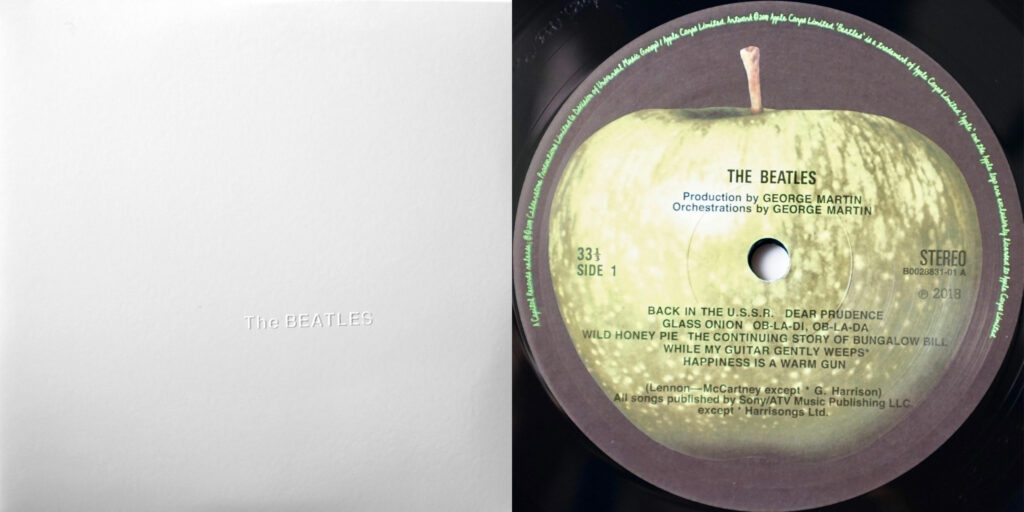
Listening to both in full: both sound extremely good and very similar. Insanely powerful bass on vinyl and very delicate clippety-clops. Especially powerful right before “I look at the world and notice it’s turning.”
Wow, the slamming bass seems to slam significantly harder on vinyl. Digital sounds huge, controlled — but so does the vinyl, though it seems to hit a little harder. There is, however, an “air sucking out of my ear” effect with deep bass in the HE1000v2s that doesn’t seem to happen with vinyl. Despite this (did I really enjoy this feeling?), the bass is both more present, deeper, and harder-hitting on vinyl.
This is a definite, unambiguous win for vinyl. I’m surprised.
9. Dungen, “Panda,” Ta Det Lugnt (2004)
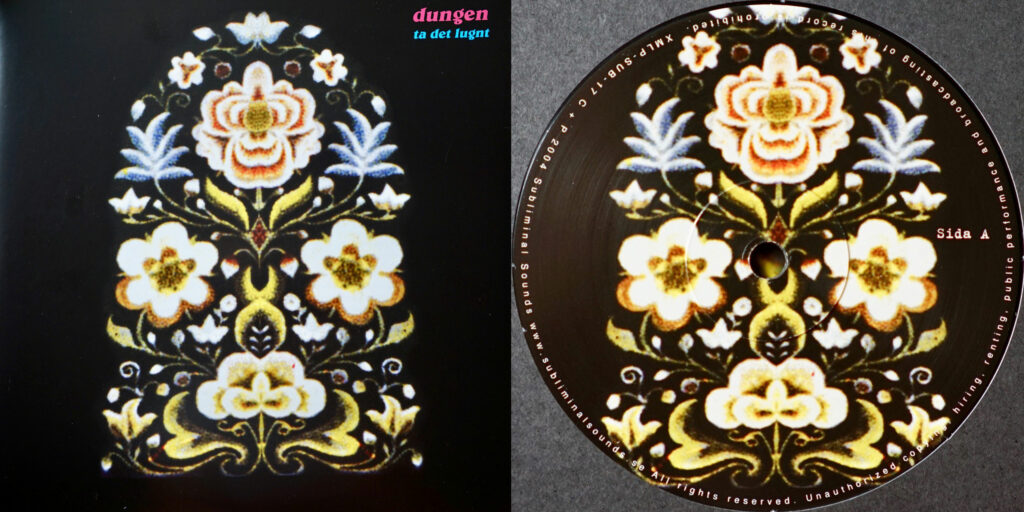
Listened to digital first… sounds good, but is the bass maybe a bit hidden, buried?
Listening to vinyl now… Well, opening drums couldn’t sound much f@#king better than that. Wow. Bass is actually in a similar place in the mix compared with digital.
Back to back: this time it’s the digital that seems bass-heavy. But not in a natural way. It’s duller. Vinyl just f%$king slams with textures, everything is so alive and cutting… Digital is great too, but definitely just a bit less alive. The negative take on the vinyl is that it’s maybe a bit coarse? But f#@k, since this track has so much insane distorted guitar, that coarseness is probably just true to the source. I definitely just want to listen to the vinyl more. Incredible depth in the echoes and noises at the close.
Another big win for vinyl.
[Ed: I’m really not much of a swearer. If I used the F-word three times here, it must have sounded really f$%king good.]
10. Julee Cruise, “Rocking Back Inside My Heart,” Floating Into the Night (1989)
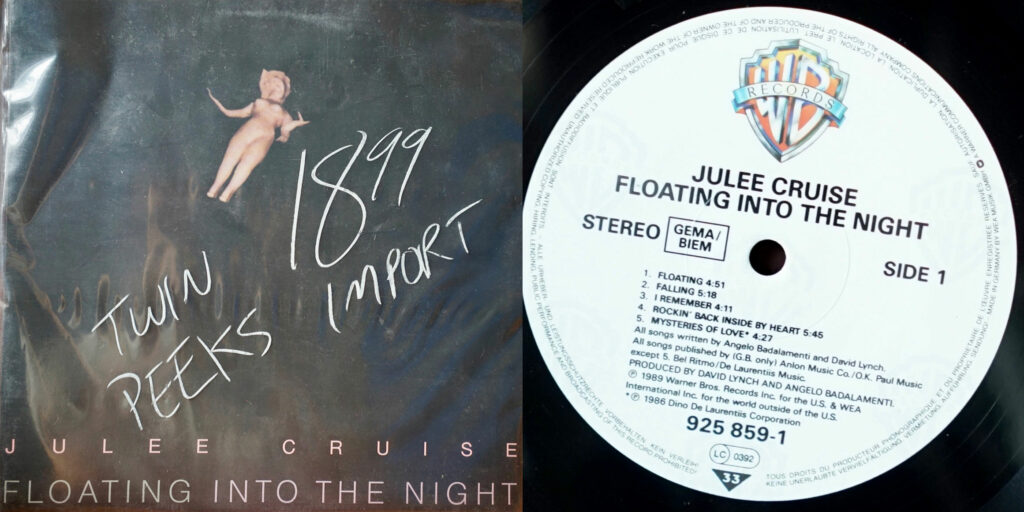
Listening on vinyl. Sounds beautiful, what can I say? It really is hard to imagine it sounding better. Why am I spending all this money to see if something can sound better than this, when it already sounds so good? Deep, crisp bass, crisp tinkles, beautiful voice, sharp, edgy sax in the breakdown. Also: good Lord, what an amazing pressing. Who said 80s pressings were bad?
Listening on digital. Still nice. Maybe a little less crisp? Still obviously sounds really good. Okay, time for the comparison.
Direct comparison: Yeah, on vinyl a bit more detail and edge on the high-end, especially the palm-muted electric guitar. More quantity of bass — but perhaps less defined? I prefer the sound of the vinyl, especially the detail and definition. The bass in where you notice this. A bit less “clunk” on vinyl but rounder, bigger, more pleasant to my ears.
This is a rare case where I can actually perceive a difference in soundstage in my headphones (usually, soundstage is only really apparently through speakers). The clinky piano on the left channel is further to the left and has more definition on vinyl.
Everything seems a little evened off on digital. The sax doesn’t break out of the mix as well, or stand out as much.
Another fairly obvious win for vinyl.
11. Can, “Halleluwah,” Tago Mago (1971)
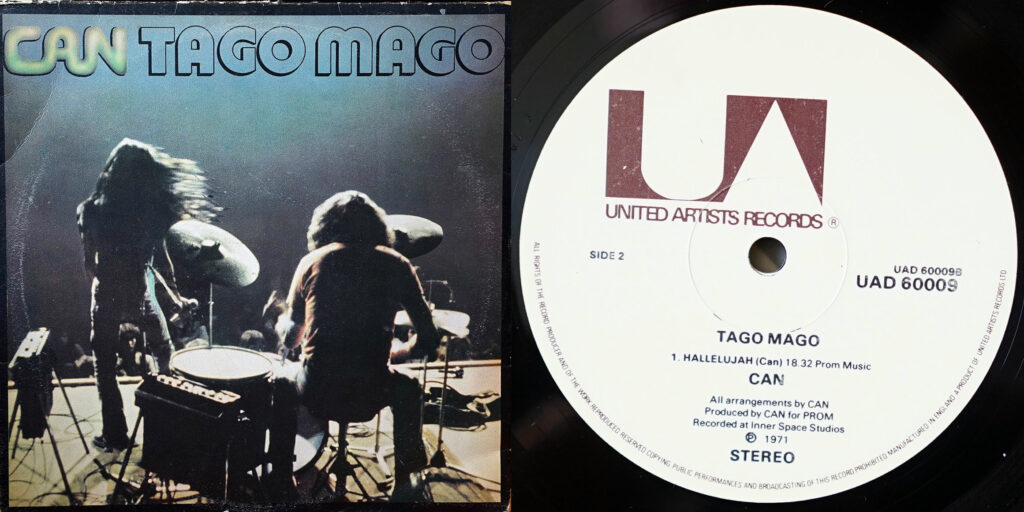
These both sound extremely f#$king good. Wow. Honestly, there isn’t much to tell them apart. Maybe the percussion on the left channel around 4:00 is slightly more defined on digital. The shaker at 4:20 maybe too. But they’re both incredible, totally palpable.
(THIS UA PRESSING IS AMAZING!!!!)
The tickle sounds at 5:30ish are a tiny bit better on digital, but still extremely good on both. I think we need to call this one a wash, with the digital having just a slight end on detail and realness. (But the seriously-this-sound-is-coming-from-a-50-year-old-piece-of-plastic? effect definitely makes me more impressed by the vinyl!) Little bit more glare and glaze, haze on vinyl.
The one place that vinyl wins is on a slightly increased quantity of bass (obv this is either my cart or my phono preamp). Yeah, I’m noticing this more now… a bit more heft, in a nice way. Like a fuller spectrum at the low end, in a good way. Whoa, but cymbals have more life and decay on digital… very noticeable.
Overall, ridiculously little to separate them, though.
12. Bill Callahan, “Javelin Unlanding,” Dream River (2013)
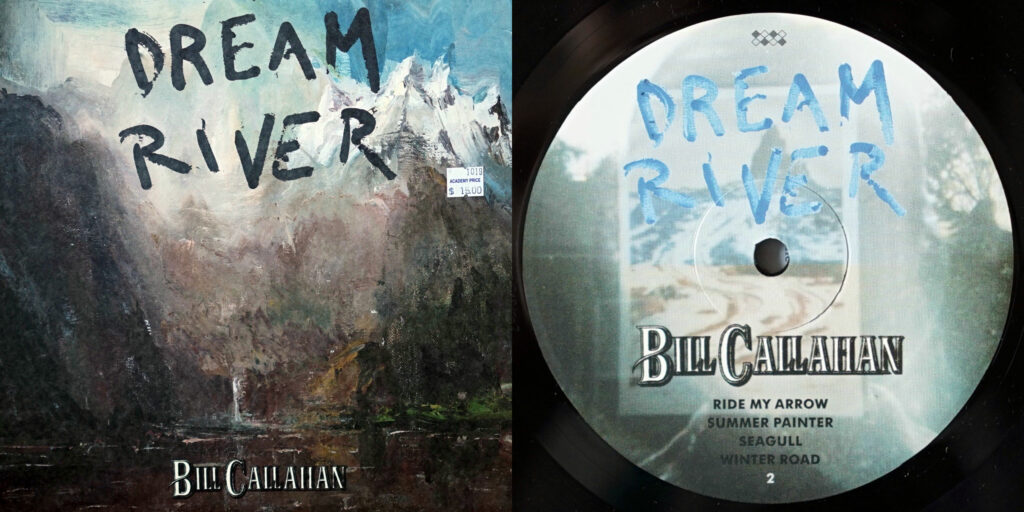
Sounds beautiful on vinyl, no doubt. Voice goes super deep.
Sounds boxy at first (on both), then really opens up when the bass comes in. Sounds amazing on digital, too. My impression: maybe the bass is deeper and more present on digital. Yep, seems like the bass is hitting way harder on digital. Maybe loudness? Partially, but not entirely. The bass just hits harder on digital.
On the brush texture after first chorus both are equal.
Right channel percussion around “First draft’s in ashes” sounds more present on vinyl — same with the congas or whatever in the second chorus. On digital, both sound constrained.
But the second-to-second comparison suggests they’re very similar, though the difference in loudness makes it hard to do the directly back-and-forth toggling.
In conclusion
Okay, those are my impressions of the differences in my two setups before any modification. I will now listen to lots of music, including all of my test albums, on the Base + Mober setup for a few weeks, then repeat all of these A-B comparisons. Will the bass still hit as hard with the Mober? Will the amount of detail increase? Will relatively shitty pressings shine in the new setup, or stay shitty? Will excellent pressings remain excellent, or sound more excellent? These are the pressing (pun intended), life-and-death questions I’ll be answering in future posts…

